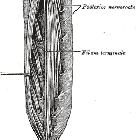tight filum terminale syndrome



Tight filum terminale syndrome, or tight filum syndrome, is a subtype of the tethered cord syndrome that is attributed to a thick, short, and/or otherwise inelastic filum terminale rather than other tethering agents.
Terminology
The term "tight filum terminale syndrome" is synonymous with "tethered cord syndrome" secondary to a "tight filum terminale." The emphasis on "syndrome" highlights a clinical diagnosis made by the synthesis of symptoms, neurologic exam signs, and laboratory tests such as urodynamics. In contrast, "tight filum terminale" is a pathoanatomic finding, which may or may not be visible radiologically or associated with the clinical syndrome.
When the clinical syndrome is present but imaging is normal (conus medullaris is normally positioned, filum terminale appears normal in size and signal, and other tethering agents are absent), the term occult filum terminale syndrome is used to imply that an inelastic but grossly normal-appearing filum terminale may be the culprit . This diagnosis remains controversial . The term occult tethered cord syndrome is synonymous because a histologic abnormality in the filum terminale is the implied diagnosis by exclusion .
Confusingly, "tethered cord syndrome" is sometimes used synonymously, as if to imply that a tight filum terminale is the main etiology of the tethered cord syndrome, even though in actuality there are many other etiologies. This ambiguity dates back to the first introduction of the term "tethered cord syndrome" by Hoffman and colleagues in 1976, who described a series of patients with spina bifida occulta and neurologic symptoms as well as a low conus and/or thick filum identified on iophenyldate myelography, i.e., the entity previously termed filum terminale syndrome . These authors claimed that this etiology "far outnumbers the more obvious forms of spinal dysraphism," even though patients with those disorders were excluded from the study . Since that time, the concept of tethered cord syndrome has been expanded to include that associated with the other spinal dysraphisms and other causes such as acquired adhesions.
Epidemiology
In one surgical case series of children treated for tethered cord syndrome, tight filum terminale was the cause in 16% .
Pathology
The condition is caused by incomplete involution of the distal spinal cord during development . Histologically, tight fila have increased/denser fibrous and adipose connective tissue . Tightness of the filum terminale results in stretching of the distal spinal cord with chronic ischemic changes .
Radiographic features
Two major imaging findings characterize tight filum terminale syndrome :
- short filum: low-lying conus medullaris terminating inferior to L2
- thick filum: greater than 2 mm diameter, often fatty
Either, both, or neither finding can be seen in the syndrome; i.e., an inelastic tight filum could have strictly normal imaging findings . Additional findings are noted below.
Ultrasound
There may be reduced motion of the conus medullaris .
MRI
A fatty filum shows high signal on T1-weighted images.
A tight filum is usually dorsally positioned (in contact with the posterior dura rather than in between the cauda equina nerve roots), especially on prone imaging . There may be gradual tapering of the conus medullaris into the filum and the distal spinal cord appears straight (tense) rather than curved (relaxed), although these findings have unclear reliability .
Treatment and prognosis
The treatment is surgical sectioning of the lower end of the filum. The vast majority (90%) of children with tight filum terminale have stable to improved neurologic function following surgery .
History and etymology
American orthopedic surgeon George J Garceau (1896–1977) first described "the filum terminale syndrome" in 1953, hypothesizing that "a tight filum terminale may cause the cord-traction symptoms known as the Arnold-Chiari syndrome" .
Siehe auch:

 Assoziationen und Differentialdiagnosen zu tight filum terminale syndrome:
Assoziationen und Differentialdiagnosen zu tight filum terminale syndrome:




